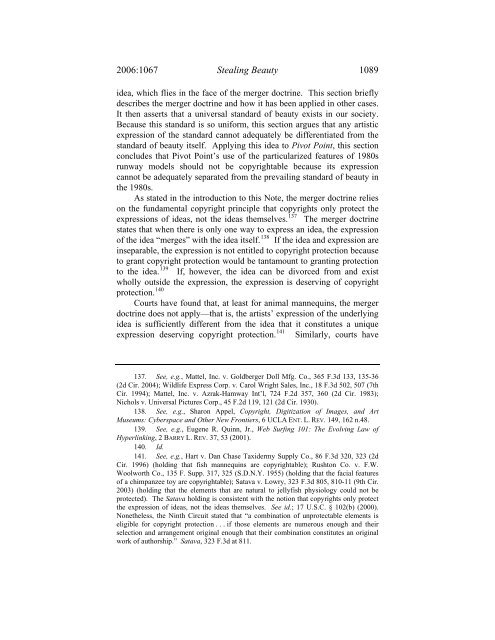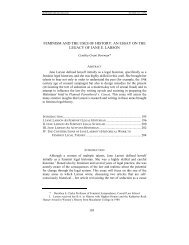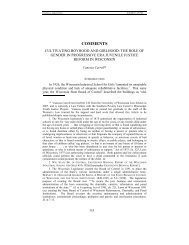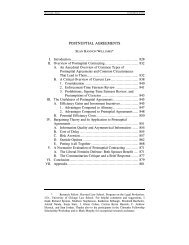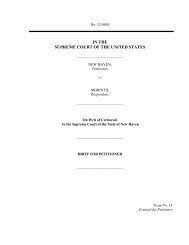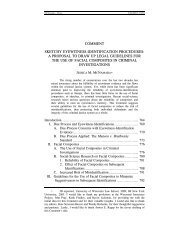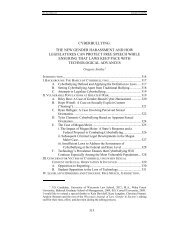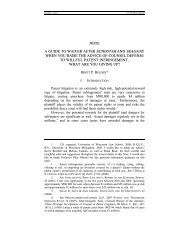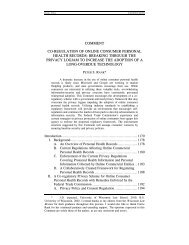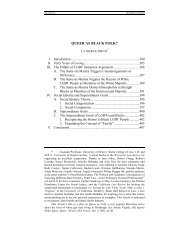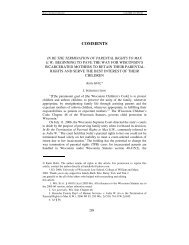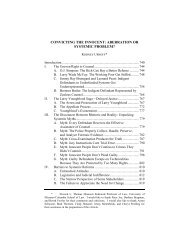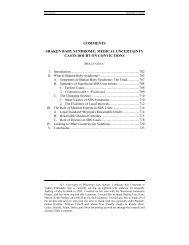Stealing Beauty: Pivot Point International v ... - UW Law School
Stealing Beauty: Pivot Point International v ... - UW Law School
Stealing Beauty: Pivot Point International v ... - UW Law School
Create successful ePaper yourself
Turn your PDF publications into a flip-book with our unique Google optimized e-Paper software.
2006:1067 <strong>Stealing</strong> <strong>Beauty</strong> 1089<br />
idea, which flies in the face of the merger doctrine. This section briefly<br />
describes the merger doctrine and how it has been applied in other cases.<br />
It then asserts that a universal standard of beauty exists in our society.<br />
Because this standard is so uniform, this section argues that any artistic<br />
expression of the standard cannot adequately be differentiated from the<br />
standard of beauty itself. Applying this idea to <strong>Pivot</strong> <strong>Point</strong>, this section<br />
concludes that <strong>Pivot</strong> <strong>Point</strong>’s use of the particularized features of 1980s<br />
runway models should not be copyrightable because its expression<br />
cannot be adequately separated from the prevailing standard of beauty in<br />
the 1980s.<br />
As stated in the introduction to this Note, the merger doctrine relies<br />
on the fundamental copyright principle that copyrights only protect the<br />
expressions of ideas, not the ideas themselves. 137 The merger doctrine<br />
states that when there is only one way to express an idea, the expression<br />
of the idea “merges” with the idea itself. 138 If the idea and expression are<br />
inseparable, the expression is not entitled to copyright protection because<br />
to grant copyright protection would be tantamount to granting protection<br />
to the idea. 139 If, however, the idea can be divorced from and exist<br />
wholly outside the expression, the expression is deserving of copyright<br />
protection. 140<br />
Courts have found that, at least for animal mannequins, the merger<br />
doctrine does not apply—that is, the artists’ expression of the underlying<br />
idea is sufficiently different from the idea that it constitutes a unique<br />
expression deserving copyright protection. 141 Similarly, courts have<br />
137. See, e.g., Mattel, Inc. v. Goldberger Doll Mfg. Co., 365 F.3d 133, 135-36<br />
(2d Cir. 2004); Wildlife Express Corp. v. Carol Wright Sales, Inc., 18 F.3d 502, 507 (7th<br />
Cir. 1994); Mattel, Inc. v. Azrak-Hamway Int’l, 724 F.2d 357, 360 (2d Cir. 1983);<br />
Nichols v. Universal Pictures Corp., 45 F.2d 119, 121 (2d Cir. 1930).<br />
138. See, e.g., Sharon Appel, Copyright, Digitization of Images, and Art<br />
Museums: Cyberspace and Other New Frontiers, 6 UCLA ENT. L. REV. 149, 162 n.48.<br />
139. See, e.g., Eugene R. Quinn, Jr., Web Surfing 101: The Evolving <strong>Law</strong> of<br />
Hyperlinking, 2 BARRY L. REV. 37, 53 (2001).<br />
140. Id.<br />
141. See, e.g., Hart v. Dan Chase Taxidermy Supply Co., 86 F.3d 320, 323 (2d<br />
Cir. 1996) (holding that fish mannequins are copyrightable); Rushton Co. v. F.W.<br />
Woolworth Co., 135 F. Supp. 317, 325 (S.D.N.Y. 1955) (holding that the facial features<br />
of a chimpanzee toy are copyrightable); Satava v. Lowry, 323 F.3d 805, 810-11 (9th Cir.<br />
2003) (holding that the elements that are natural to jellyfish physiology could not be<br />
protected). The Satava holding is consistent with the notion that copyrights only protect<br />
the expression of ideas, not the ideas themselves. See id.; 17 U.S.C. § 102(b) (2000).<br />
Nonetheless, the Ninth Circuit stated that “a combination of unprotectable elements is<br />
eligible for copyright protection . . . if those elements are numerous enough and their<br />
selection and arrangement original enough that their combination constitutes an original<br />
work of authorship.” Satava, 323 F.3d at 811.


